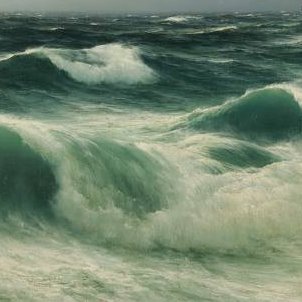Courage, 60 x 60 inches
Power, 30 x 30 inches
Kelly's facebook page
Wednesday, June 15, 2011
Friday, June 10, 2011
Textured supports
Konstantin Westchilov (Russian), Rocky Coast.
Some of the art auction houses have zoomable images of the lots. This allows you to see the brushstrokes up close, and is very instructive. By looking closely at the distant cliffs, this painting looks as if it's been done on the rough side of masonite; a texture I find distracting. I prefer the look of canvas. But Westchilov seems to have applied the paint thickly enough to cover it.
As a general rule, the thickness and texture of the paint should be reduced from foreground to background. This helps create the illusion of distance. The distant cliffs in this work have been painted thinly and this is where the texture of the support is quite visible, to the point where it becomes a bit of a problem (see cliff in bottom detail). There are some paintings where the artist has deliberately chosen to express the texture of the support, but this is usually in an area of the painting where is simulates the weave of fabric in clothing, for example.
Some say that masonite contains acid and eventually degrades, potentially destroying a painting, but perhaps it depends on the manufacturing quality. The more thoroughly the masonite is primed the better, to create a barrier between the oil paint and the wood acids in the masonite.
I love Westchilov's brushstrokes in the waves.
Tuesday, May 31, 2011
Monday, May 23, 2011
Blue and Orange
On the Suffolk Coast
I love the way Willard Leroy Metcalf has used just a touch of orange, in the form of light from the setting sun striking the hull of the boat, to complement the blue in this work. Complementary colors make each other appear more intense, producing a richer painting. Here they have been used with great subtlety and imagination. The orange patch draws attention to the huge fish.
Complementaries produce an interesting grey when mixed together. If the two colours are only lightly mixed, preserving a little separation, the resulting grey will have an iridescent quality a bit like shot silk.
The greys in the clouds may have been mixed this way.
Friday, May 13, 2011
Tranquillity
Two Ladies in a Rowboat, 38 x 28 inches
Alfred Thomas Bircher (1837-1908) was a luminist and one of the last painters of the Hudson River School, one of the best-known schools in American art. With the advent of Modernism, the luminist style - and landscape painting in general - fell out of favor; however, in more recent times Bricher's work has seen a revival, and he is now recognised as one of the foremost marine painters of the 19th century.
While storm-whipped waves provide a seascape with drama, the more tranquil moods of the sea give scope for the luminist exploration of light reflecting on the surface of water.
Bricher painted many of these calm, reflective coastal scenes. He often contrasts the smooth, mirror-like surface of the water with rugged cliffs and highly textured clouds.
Bricher painted many of these calm, reflective coastal scenes. He often contrasts the smooth, mirror-like surface of the water with rugged cliffs and highly textured clouds.
As a lover of maritime life and the sea he purchased a home in the 1890s close to the sea in the New Dorp section of Staten Island where he had views of the Atlantic Ocean and Raritan Bay. He lived and painted at the shore in New Dorp until his death in 1908.
detail
Wednesday, May 4, 2011
Horace Champagne
This pastel piece, by the Canadian artist Horace Champagne, keeps superfluous elements to a minimum in order to focus on the power and beauty of the surf. A glimpse of neutral grey rocks and sky, a single sea bird, is all that's needed to set the stage for the drama of waves and spray. White at the top is balanced by white at the bottom, linked via a zigzag path of foam.
Subscribe to:
Posts (Atom)














































